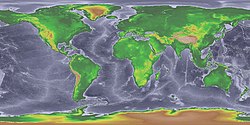Pleistoseno
Ang Pleistoseno (Ingles: Pleistocene (![]() /ˈplaɪstəsiːn/) at may simbolong PS[5]) ang epoch na heolohiko na tumagal mula mga 2,588,000 hanggang 11,700 taon ang nakalilipas na sumasaklw sa kamakailang panahon ng paulit ulit na mga glasiasyon(pagyeyelo) ng daigdig. Ang Pleistocene ay hinango sa Griyegong πλεῖστος (pleistos "karamihan") and καινός (kainos "bago"). Ipinakilala ni Sir Charles Lyell ang terminong ito noong 1839 upang ilarawan ang strata sa Sicily na may hindi bababa sa 70% ng mga faunang molluska na namumuhay pa rin sa kasalukuyan. Ito ay nagtatangi ng epoch na ito mula sa mas matandang Plioseno na orihinal na inakala ni Lyell na pinaka-batang patong ng batong fossil. Ang Pleistoseno ay sumusunod sa Plioseno at sinusundan ng Holoseno. Ang Pleistoseno ang unang epoch ng Kwaternaryo o ikaanim na epoch ng era na Cenosoiko.[6] Ang wakas ng Pleistoseno ay tumutugon sa wakas ng huling panahong yelo. Ito ay tumutugon rin sa wakas ng panahong Paleolitiko sa arkeolohiya. The end of the Pleistocene corresponds with the end of the last glacial period. Sa iskala ng panahong ICS, ang Pleistoseno ay nahahati sa apat na mga yugto: ang Gelasian, Calabrian, Ionian at Tarantian. Ang lahat ng mga yugtong ito ay inilalarawan sa katimugang Europa. Sa karagdagan sa subdisbisyong internasyonal na ito, ang iba't ibang mga subdibisyong pang-rehiyon ay kadalasang ginagamit. Bago ang isang pagbabago sa wakas ay kinumpirma noong 2009 ng International Union of Geological Sciences, ang hangganan sa pagitan ng Pleistoseno at ang naunang Plioseno ay itinuturing na nasa 1.806 at hindi 2.588 milyong taon BP. Ang mga publikasyon mula sa mga naunang taon ay maaaring gumait ng kahit anong depinisyon ng panahon.
/ˈplaɪstəsiːn/) at may simbolong PS[5]) ang epoch na heolohiko na tumagal mula mga 2,588,000 hanggang 11,700 taon ang nakalilipas na sumasaklw sa kamakailang panahon ng paulit ulit na mga glasiasyon(pagyeyelo) ng daigdig. Ang Pleistocene ay hinango sa Griyegong πλεῖστος (pleistos "karamihan") and καινός (kainos "bago"). Ipinakilala ni Sir Charles Lyell ang terminong ito noong 1839 upang ilarawan ang strata sa Sicily na may hindi bababa sa 70% ng mga faunang molluska na namumuhay pa rin sa kasalukuyan. Ito ay nagtatangi ng epoch na ito mula sa mas matandang Plioseno na orihinal na inakala ni Lyell na pinaka-batang patong ng batong fossil. Ang Pleistoseno ay sumusunod sa Plioseno at sinusundan ng Holoseno. Ang Pleistoseno ang unang epoch ng Kwaternaryo o ikaanim na epoch ng era na Cenosoiko.[6] Ang wakas ng Pleistoseno ay tumutugon sa wakas ng huling panahong yelo. Ito ay tumutugon rin sa wakas ng panahong Paleolitiko sa arkeolohiya. The end of the Pleistocene corresponds with the end of the last glacial period. Sa iskala ng panahong ICS, ang Pleistoseno ay nahahati sa apat na mga yugto: ang Gelasian, Calabrian, Ionian at Tarantian. Ang lahat ng mga yugtong ito ay inilalarawan sa katimugang Europa. Sa karagdagan sa subdisbisyong internasyonal na ito, ang iba't ibang mga subdibisyong pang-rehiyon ay kadalasang ginagamit. Bago ang isang pagbabago sa wakas ay kinumpirma noong 2009 ng International Union of Geological Sciences, ang hangganan sa pagitan ng Pleistoseno at ang naunang Plioseno ay itinuturing na nasa 1.806 at hindi 2.588 milyong taon BP. Ang mga publikasyon mula sa mga naunang taon ay maaaring gumait ng kahit anong depinisyon ng panahon.
| Pleistoseno | |||||||||
|---|---|---|---|---|---|---|---|---|---|
| 2.58 – 0.0117 milyong taon ang nakakalipas | |||||||||
 Mapa ng mundo noong Huling Maximum na TagYeloMap of the world during the Last Glacial Maximum | |||||||||
| Kronolohiya | |||||||||
| |||||||||
| Etimolohiya | |||||||||
| Pormal | Formal | ||||||||
| Impormasyon sa paggamit | |||||||||
| Celestial body | Earth | ||||||||
| Paggamit panrehiyon | Global (ICS) | ||||||||
| Kahulugan | |||||||||
| Yunit kronolohikal | Epoch | ||||||||
| Yunit stratigrapiko | Series | ||||||||
| Pormal na time span | Formal | ||||||||
| Kahulugan ng mababang hangganan |
| ||||||||
| Lower boundary GSSP | Monte San Nicola Section, Gela, Sicily, Italy 37°08′49″N 14°12′13″E / 37.1469°N 14.2035°E | ||||||||
| GSSP ratified | 2009 (as base of Quaternary and Pleistocene)[3] | ||||||||
| Upper boundary definition | End of the Younger Dryas stadial | ||||||||
| Upper boundary GSSP | NGRIP2 ice core, Greenland 75°06′00″N 42°19′12″W / 75.1000°N 42.3200°W | ||||||||
| GSSP ratified | 2008 (as base of Holocene)[4] | ||||||||
Mga sanggunian
baguhin- ↑ Cohen, K. M.; Finney, S. C.; Gibbard, P. L.; Fan, J.-X. (Enero 2020). "International Chronostratigraphic Chart" (PDF). International Commission on Stratigraphy. Nakuha noong 23 Pebrero 2020.
{{cite web}}: CS1 maint: date auto-translated (link) - ↑ Mike Walker; atbp. (Disyembre 2018). "Formal ratification of the subdivision of the Holocene Series/Epoch (Quaternary System/Period)" (PDF). Episodes. Subcommission on Quaternary Stratigraphy (SQS). 41 (4): 213–223. doi:10.18814/epiiugs/2018/018016. Nakuha noong 11 Nobyembre 2019.
{{cite journal}}: CS1 maint: date auto-translated (link) - ↑ Gibbard, Philip; Head, Martin (Setyembre 2010). "The newly-ratified definition of the Quaternary System/Period and redefinition of the Pleistocene Series/Epoch, and comparison of proposals advanced prior to formal ratification" (PDF). Episodes. 33 (3): 152–158. doi:10.18814/epiiugs/2010/v33i3/002. Nakuha noong 8 Disyembre 2020.
{{cite journal}}: CS1 maint: date auto-translated (link) - ↑ Walker, Mike; Johnse, Sigfus; Rasmussen, Sune; Steffensen, Jørgen-Peder; Popp, Trevor; Gibbard, Phillip; atbp. (Hunyo 2008). "The Global Stratotype Section and Point (GSSP) for the base of the Holocene Series/Epoch (Quaternary System/Period) in the NGRIP ice core". Episodes. 31 (2): 264–267. doi:10.18814/epiiugs/2008/v31i2/016.
{{cite journal}}: CS1 maint: date auto-translated (link) - ↑ "Geologic Age Symbol Font (StratagemAge)" (PDF). USGS. 99-430. Nakuha noong 2011-06-22.
{{cite web}}: CS1 maint: date auto-translated (link) - ↑ Gibbard, P. and van Kolfschoten, T. (2004) "The Pleistocene and Holocene Epochs" Chapter 22PDF (3.1 MB) In Gradstein, F. M., Ogg, James G., and Smith, A. Gilbert (eds.), A Geologic Time Scale 2004 Cambridge University Press, Cambridge, ISBN 0-521-78142-6